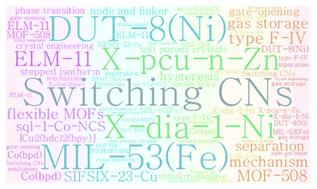当前位置:
X-MOL 学术
›
Faraday Discuss.
›
论文详情
Our official English website, www.x-mol.net, welcomes your
feedback! (Note: you will need to create a separate account there.)
Spiers Memorial Lecture: Coordination networks that switch between nonporous and porous structures: an emerging class of soft porous crystals
Faraday Discussions ( IF 3.3 ) Pub Date : 2021-06-14 , DOI: 10.1039/d1fd00037c Shi-Qiang Wang 1 , Soumya Mukherjee 1, 2 , Michael J Zaworotko 1
Faraday Discussions ( IF 3.3 ) Pub Date : 2021-06-14 , DOI: 10.1039/d1fd00037c Shi-Qiang Wang 1 , Soumya Mukherjee 1, 2 , Michael J Zaworotko 1
Affiliation

|
Coordination networks (CNs) are a class of (usually) crystalline solids typically comprised of metal ions or cluster nodes linked into 2 or 3 dimensions by organic and/or inorganic linker ligands. Whereas CNs tend to exhibit rigid structures and permanent porosity as exemplified by most metal–organic frameworks, MOFs, there exists a small but growing class of CNs that can undergo extreme, reversible structural transformation(s) when exposed to gases, vapours or liquids. These “soft” or “stimuli-responsive” CNs were introduced two decades ago and are attracting increasing attention thanks to two features: the amenability of CNs to design from first principles, thereby enabling crystal engineering of families of related CNs; and the potential utility of soft CNs for adsorptive storage and separation. A small but growing subset of soft CNs exhibit reversible phase transformations between nonporous (closed) and porous (open) structures. These “switching CNs” are distinguished by stepped sorption isotherms coincident with phase transformation and, perhaps counterintuitively, they can exhibit benchmark properties with respect to working capacity (storage) and selectivity (separation). This review addresses fundamental and applied aspects of switching CNs through surveying their sorption properties, analysing the structural transformations that enable switching, discussing structure–function relationships and presenting design principles for crystal engineering of the next generation of switching CNs.
中文翻译:

Spiers 纪念讲座:在无孔和多孔结构之间切换的配位网络:一类新兴的软多孔晶体
配位网络 (CN) 是一类(通常)结晶固体,通常由金属离子或簇节点组成,通过有机和/或无机连接配体连接成 2 或 3 维。尽管 CNs 往往表现出刚性结构和永久性孔隙率,如大多数金属有机框架 MOFs 所示,但仍有一小部分 CNs 在暴露于气体、蒸汽或液体时会发生极端的、可逆的结构转变。这些“软”或“刺激响应”的 CNs 是在 20 年前引入的,并且由于两个特点而引起了越来越多的关注: CNs 从第一原理设计的顺从性,从而使相关 CNs 家族的晶体工程成为可能;以及软CNs在吸附储存和分离方面的潜在用途。一小部分但不断增长的软 CNs 在无孔(封闭)和多孔(开放)结构之间表现出可逆的相变。这些“转换 CN”的特点是与相变相一致的阶梯式吸附等温线,并且可能与直觉相反,它们可以在工作能力(存储)和选择性(分离)方面表现出基准特性。本综述通过调查 CNs 的吸附特性、分析实现转换的结构转变、讨论结构-功能关系以及提出下一代转换 CNs 晶体工程的设计原则,探讨了转换 CNs 的基本和应用方面。这些“转换 CN”的特点是与相变相一致的阶梯式吸附等温线,并且可能与直觉相反,它们可以在工作能力(存储)和选择性(分离)方面表现出基准特性。本综述通过调查 CNs 的吸附特性、分析实现转换的结构转变、讨论结构-功能关系以及提出下一代转换 CNs 晶体工程的设计原则,探讨了转换 CNs 的基本和应用方面。这些“转换 CN”的特点是与相变相一致的阶梯式吸附等温线,并且可能与直觉相反,它们可以在工作能力(存储)和选择性(分离)方面表现出基准特性。本综述通过调查 CNs 的吸附特性、分析实现转换的结构转变、讨论结构-功能关系以及提出下一代转换 CNs 晶体工程的设计原则,探讨了转换 CNs 的基本和应用方面。
更新日期:2021-07-27
中文翻译:

Spiers 纪念讲座:在无孔和多孔结构之间切换的配位网络:一类新兴的软多孔晶体
配位网络 (CN) 是一类(通常)结晶固体,通常由金属离子或簇节点组成,通过有机和/或无机连接配体连接成 2 或 3 维。尽管 CNs 往往表现出刚性结构和永久性孔隙率,如大多数金属有机框架 MOFs 所示,但仍有一小部分 CNs 在暴露于气体、蒸汽或液体时会发生极端的、可逆的结构转变。这些“软”或“刺激响应”的 CNs 是在 20 年前引入的,并且由于两个特点而引起了越来越多的关注: CNs 从第一原理设计的顺从性,从而使相关 CNs 家族的晶体工程成为可能;以及软CNs在吸附储存和分离方面的潜在用途。一小部分但不断增长的软 CNs 在无孔(封闭)和多孔(开放)结构之间表现出可逆的相变。这些“转换 CN”的特点是与相变相一致的阶梯式吸附等温线,并且可能与直觉相反,它们可以在工作能力(存储)和选择性(分离)方面表现出基准特性。本综述通过调查 CNs 的吸附特性、分析实现转换的结构转变、讨论结构-功能关系以及提出下一代转换 CNs 晶体工程的设计原则,探讨了转换 CNs 的基本和应用方面。这些“转换 CN”的特点是与相变相一致的阶梯式吸附等温线,并且可能与直觉相反,它们可以在工作能力(存储)和选择性(分离)方面表现出基准特性。本综述通过调查 CNs 的吸附特性、分析实现转换的结构转变、讨论结构-功能关系以及提出下一代转换 CNs 晶体工程的设计原则,探讨了转换 CNs 的基本和应用方面。这些“转换 CN”的特点是与相变相一致的阶梯式吸附等温线,并且可能与直觉相反,它们可以在工作能力(存储)和选择性(分离)方面表现出基准特性。本综述通过调查 CNs 的吸附特性、分析实现转换的结构转变、讨论结构-功能关系以及提出下一代转换 CNs 晶体工程的设计原则,探讨了转换 CNs 的基本和应用方面。











































 京公网安备 11010802027423号
京公网安备 11010802027423号